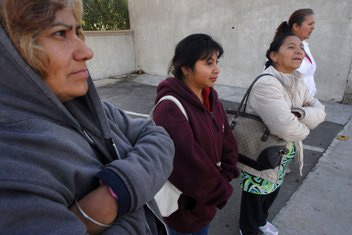Mexico's Female Faces of Recession
 Omar Millán González - San Diego Union-Tribune Omar Millán González - San Diego Union-Tribune
go to original
March 02, 2010


| | Dorotea Lugo (from left), 46, Arely López Gamboa, 26, and Lopez’s mother, Petra Gamboa, 48, waited for temporary day work at an intersection in Tijuana’s upscale Hipodromo neighborhood. (David Maung/Union-Tribune) |  |
Every day before dawn, the women leave their homes on the working-class east side of Tijuana to look for work.

Their destination is an upscale residential zone near downtown, home to wealthy businessmen and politicians, even the mayor.

Starting at 6 a.m., 30 or so women plant themselves on a sidewalk at Hipodromo and Zitacuaro avenues. They wait to be hired for the day by passing drivers, mostly to clean houses.

No one knows how long they have been congregating there. Some say five years, others 10. What is clear is that in times of economic crisis, like now, dozens more descend on the spot. Enduring the early-morning chill and chatting among themselves in small groups, they are the female face of unemployment in Baja California.

Most are 20 to 35, although there are women in their 60s who are hired mainly for child care.

As maquiladoras slashed production or closed, Baja California registered the second-highest number of job losses among Mexican states last year, according to the federal government.

The state’s unemployment rate has increased sharply from 2.6 percent to 6.3 percent in the past two years, according to the Department of Economic Development.

Alma Mendoza, 30, was among those laid off. Until four months ago, she worked at an assembly plant earning 750 pesos (a little more than $60) a week.

She has searched for similar work but hasn’t found any.

“That’s why I come here every day,” she said, standing on the pavement on a recent day.

The single mother and her two children came to Tijuana a year ago from her native city of Tuxtla Gutierrez, in the southern state of Chiapas.

If she’s lucky, she will be hired for the day and earn 200 to 300 pesos (about $16 to $20) for an eight-hour shift.

María Amelia Gerardo, 47, said she has worked as a domestic servant her whole life. But two years ago, the family she worked for five days a week told her they could afford her only one day per week.

“Since then, I started coming here,” said Gerardo, a Tijuana native.

Along with her daughter, she supports her mother and two grandchildren. She has lived through tiempos buenos (good times) in the region, she said, when there was plenty of work and she could even work on weekends if she wanted. But she has also endured bad times, like the present crisis.

Areli López Gamboa, 26, and her mother, Petra Gamboa, 48, said that for the past six months, they’ve been getting up at 4 a.m. to make it to Colonia Hipodromo by 6 a.m.

They live in El Altiplano, in the eastern part of the city. They take two buses and then walk more than a mile to the hiring spot. Then there’s nothing to do but wait as dozens of late-model cars pass by.

López said a woman hires her mother at least once a week to watch her children. “Sometimes, she gets hired and I stay here, waiting. Sometimes they hire both of us.”

Amanda Orozco said cleaning houses is one of the few options she and the other women have for employment. “We don’t have much education,” said Orozco, 32, a native of Guatemala. “The only thing we want is to support our families.”

Historically, Baja California has been one of the most economically stable states in Mexico. But it has been hard-hit by the financial crises at home, in the United States and in Asia.

At least 66,000 jobs were lost in Baja California last year, 41,672 in Tijuana alone, according to the Mexican Social Security Institute.

On Jan. 27, a maquiladora industry group sought applicants for 400 positions. About 4,000 people flocked to its building on Díaz Ordaz Boulevard, including professionals, students and housewives.

Among the ranks of the unemployed are people who used to work in the United States, domestic workers and workers who were self-employed or held part-time positions, according to Mexico’s National Institute of Statistics and Geography.

Standing on the street corner, Petronila Cruz López, 60, said she wants only one thing. “The mayor and other politicians drive by here every day and they see us,” she said.

“We’re not looking for a handout. We just want to work.”

Omar Millán González is a contributing writer to the Union-Tribune’s Spanish-language weekly, Enlace. |



